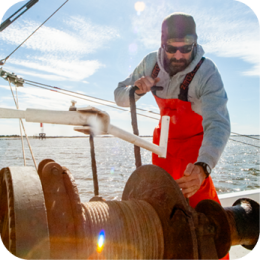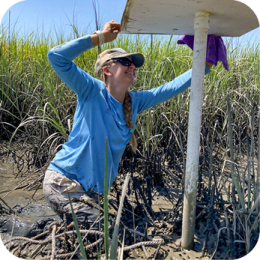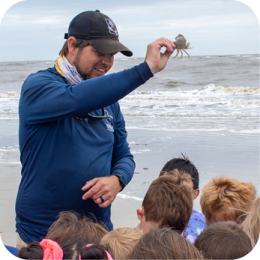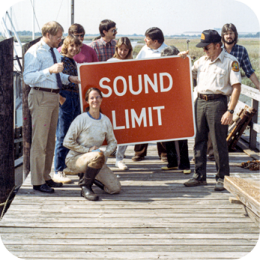
By Jenny Phillips & Susan Shipman
Coastal Resources Division
Adapted from an article in the May-June 1980 Coastlines
Georgia’s beaches, shaped by a gentle continental shelf and offshore sandbars, may not collect as many shells as other coastal states, but they still offer diverse marine life and debris for beachcombers. The shoreline provides enough variety to satisfy most collectors, featuring frequently washed-ashore marine animals and various plants and animals living on the beach. While combing Georgia’s beaches, please remember to check shells for wildlife and leave animals undisturbed. Likewise, please refrain from entering the beaches’ fragile sand dune systems.
ANIMALS
The following “beach creatures” have been grouped according to their most basic characteristics. These groups are technically referred to as phyla, the most general scientific classification.
CLAMS, SNAILS:
Phylum Mollusca
Mollusks are perhaps the most familiar beach finds, especially in the wake of a storm. They are available in many body forms but almost all have some type of eternal shell. These shells come in all shapes and sizes: coiled, bivalved (two-piece), tubular, or formed of overlapping plates. Most mollusks come equipped with a muscular foot, a mouth complete with rasplike tongue that scrapes food, and fleshy lobes that contain shellsecreting glands.
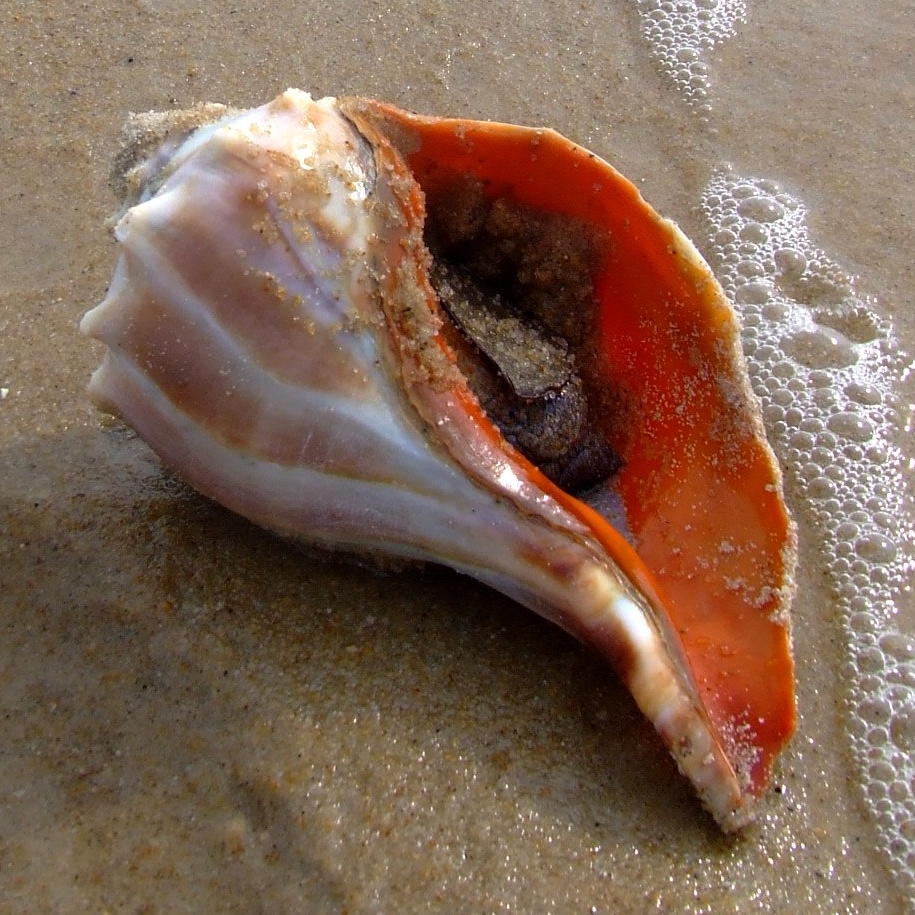 Knobbed whelks are often cast up on Georgia beaches. As you might expect, the shell is covered with knobs. The side opening of this spiraled creature reveals a smooth orange interior. Whelks feed mainly on other mollusks and are considered a delicacy in the West Indies and Europe.
Knobbed whelks are often cast up on Georgia beaches. As you might expect, the shell is covered with knobs. The side opening of this spiraled creature reveals a smooth orange interior. Whelks feed mainly on other mollusks and are considered a delicacy in the West Indies and Europe.
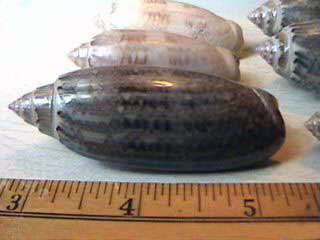 If you look carefully along the wrackline, you may happen upon a lettered olive shell. This cylindrical mollusk usually has a light colored, very glossy shell with distinctive markings. The olive, a rare find on most Georgia beaches, can grow to 2 ½ inches in length.
If you look carefully along the wrackline, you may happen upon a lettered olive shell. This cylindrical mollusk usually has a light colored, very glossy shell with distinctive markings. The olive, a rare find on most Georgia beaches, can grow to 2 ½ inches in length.
 Much more common is the moon snail, also called a shark eye. The spiraled shell is usually tan or gray and has a soft sheen. Abandoned moon snail shells are often claimed by wandering hermit crabs in search of a new home.
Much more common is the moon snail, also called a shark eye. The spiraled shell is usually tan or gray and has a soft sheen. Abandoned moon snail shells are often claimed by wandering hermit crabs in search of a new home.
 The angel wing is aptly named, not only because of its radiating ribbed shape, but also because of its pure white color. The shell is extremely brittle, so you’ll have to search to find one that is not broken. This bivalve is large -- up to 7 inches long. It lives in the subtidal zone.
The angel wing is aptly named, not only because of its radiating ribbed shape, but also because of its pure white color. The shell is extremely brittle, so you’ll have to search to find one that is not broken. This bivalve is large -- up to 7 inches long. It lives in the subtidal zone.
The great heart cockle is a resident of southern beaches. This shell, with its pronounced ribbing, looks somewhat like corduroy. When viewed from the side, the two hinged valves of this cockle form a heart shape, giving the organism its name.
HORSESHOE CRAB, MUD SHRIMP:
Phylum Arthropoda
The phylum Arthropoda is the largest in the animal world and includes an enormous variety of crustaceans, insects and spiders. All arthropods have a hard shell and jointed legs.
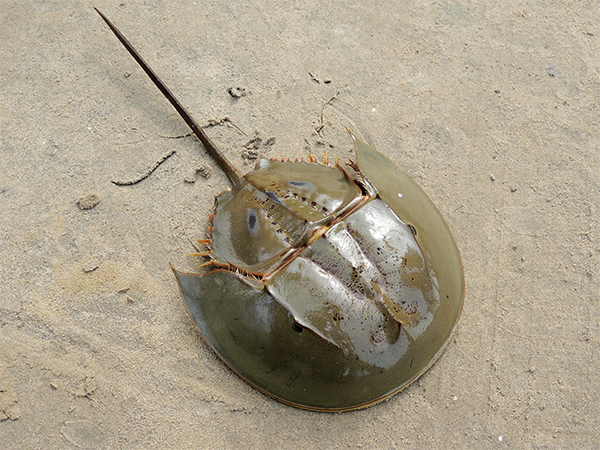 Most marine arthropods are crustaceans, but the horseshoe crab is an exception. Despite its name, this tank-like creature is more closely related to spiders than to crabs. A very primitive animal, the horseshoe traces back its ancestry more than 350 million years. This “crab” scuttles through the shallow intertidal waters with amazing speed, twitching its long tail spike. Although its appearance is somewhat awesome, the horseshoe is harmless to man. At one time, this organism was harvested for fertilizer, but now its blue blood is extracted and used in the pharmaceutical industry for testing human blood for bacteria.
Most marine arthropods are crustaceans, but the horseshoe crab is an exception. Despite its name, this tank-like creature is more closely related to spiders than to crabs. A very primitive animal, the horseshoe traces back its ancestry more than 350 million years. This “crab” scuttles through the shallow intertidal waters with amazing speed, twitching its long tail spike. Although its appearance is somewhat awesome, the horseshoe is harmless to man. At one time, this organism was harvested for fertilizer, but now its blue blood is extracted and used in the pharmaceutical industry for testing human blood for bacteria.
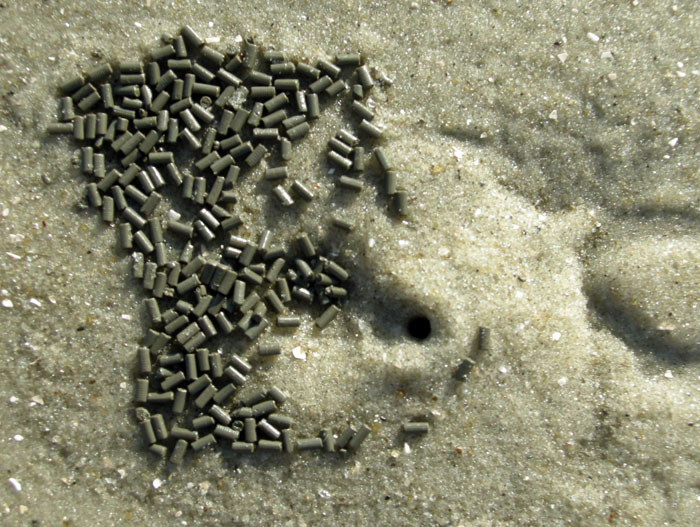 Short-browed mud shrimp or ghost shrimp are much less familiar to tidal flat enthusiasts than are their burrows, which are often surrounded by shrimp feces resembling chocolate shot. Mud shrimp burrows dot the flat landscape, you have to dig quickly to find the occupants. This mud shrimp looks somewhat like a miniature lobster, due to the large pincers on its front pair of legs.
Short-browed mud shrimp or ghost shrimp are much less familiar to tidal flat enthusiasts than are their burrows, which are often surrounded by shrimp feces resembling chocolate shot. Mud shrimp burrows dot the flat landscape, you have to dig quickly to find the occupants. This mud shrimp looks somewhat like a miniature lobster, due to the large pincers on its front pair of legs.
SAND DOLLARS, SEA CUCUMBERS:
Phylum Echinodermata
All echinoderms are marine animals, characterized by an external skeleton of calcium-like plates often covered with spines and a body form based on a five part pattern.
If you find a five-hole sand dollar fresh from the sea, you many not recognize it, for it has a mosslike covering of green spines. As the sand dollar dries on the beach, this outer layer disappears and the plated skeleton bleaches to its familiar white color. This flat disc-shaped skeleton has five keyhole slots near the outer edge of the shell.
Although sea cucumbers may look like a sponge or sea anemone they do have the skeletal plates characteristic of every echinoderm. These plates have simply degenerated and embedded themselves in the cucumber’s fleshy body. This animal’s tubed feet are a common characteristic of echinoderms.
PLANTS
The elements of salt spray, constant wind, intense light, and high temperatures combine to make the dunes a harsh place for plants to grow. Unlike their animal neighbors, plants cannot burrow to escape climatic extremes. The soil itself is a problem: sand is not noted for its ability to hold moisture. You won’t see a large variety of vegetation along the beach, but those plants you do encounter are indicative of site conditions. Grasses and vines dominate the foredunes, just back of the wrackline. Dunes further from the waterline are older and have, over time, become more stable because of the network of plant roots holding the sand in place. On these dunes you’ll find additional herbs and a few woody plants.
Here are a few species common to Georgia’s dunes and interdunes.
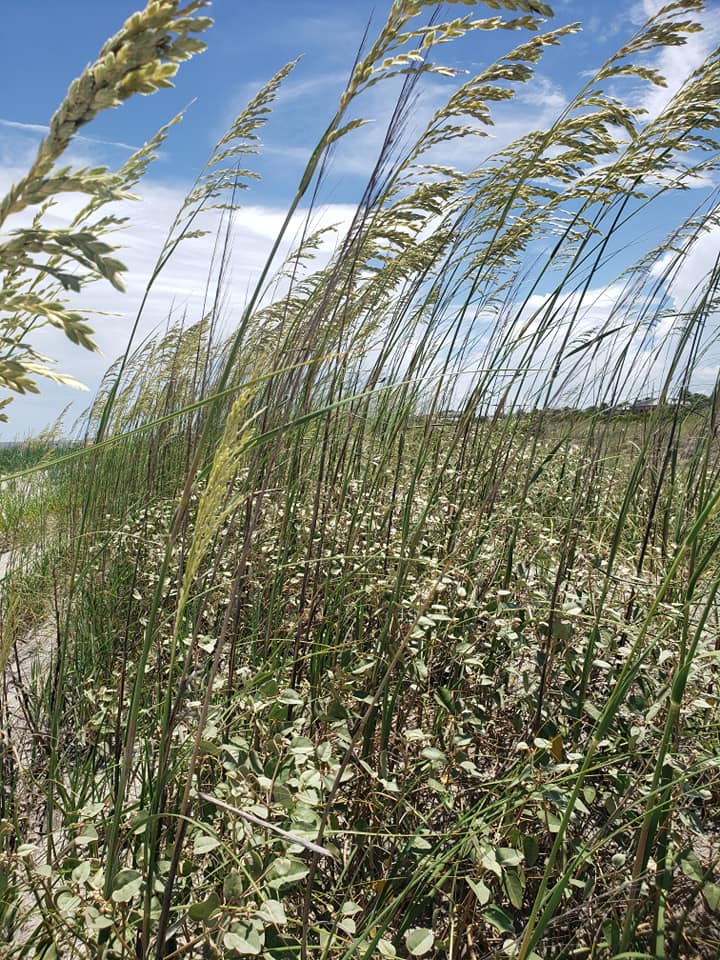 Sea Oats (Uniola paniculata) may be the best-known dune stabilizer. Protected by law from the ravages of dried plant collectors, this grass can reproduce either by sprouting seeds or by sending out underground runners, called rhizomes. Sea oats are not alone in this regard. Many beach grasses reproduce by sending out such new stems, with nodes that root and form new plants. These grasses depend on soil undisturbed by foot or vehicle traffic to allow their rhizomes a chance to spread and take hold. If these rhizomes and roots are destroyed, so is the dune, for a healthy network of stems and roots is the key to stabilizing sand.
Sea Oats (Uniola paniculata) may be the best-known dune stabilizer. Protected by law from the ravages of dried plant collectors, this grass can reproduce either by sprouting seeds or by sending out underground runners, called rhizomes. Sea oats are not alone in this regard. Many beach grasses reproduce by sending out such new stems, with nodes that root and form new plants. These grasses depend on soil undisturbed by foot or vehicle traffic to allow their rhizomes a chance to spread and take hold. If these rhizomes and roots are destroyed, so is the dune, for a healthy network of stems and roots is the key to stabilizing sand.
Sea oats are valuable stabilizers of sandy soil for another reason: They can withstand burying by sand drifts, sending up new shoots from the submerged plants.
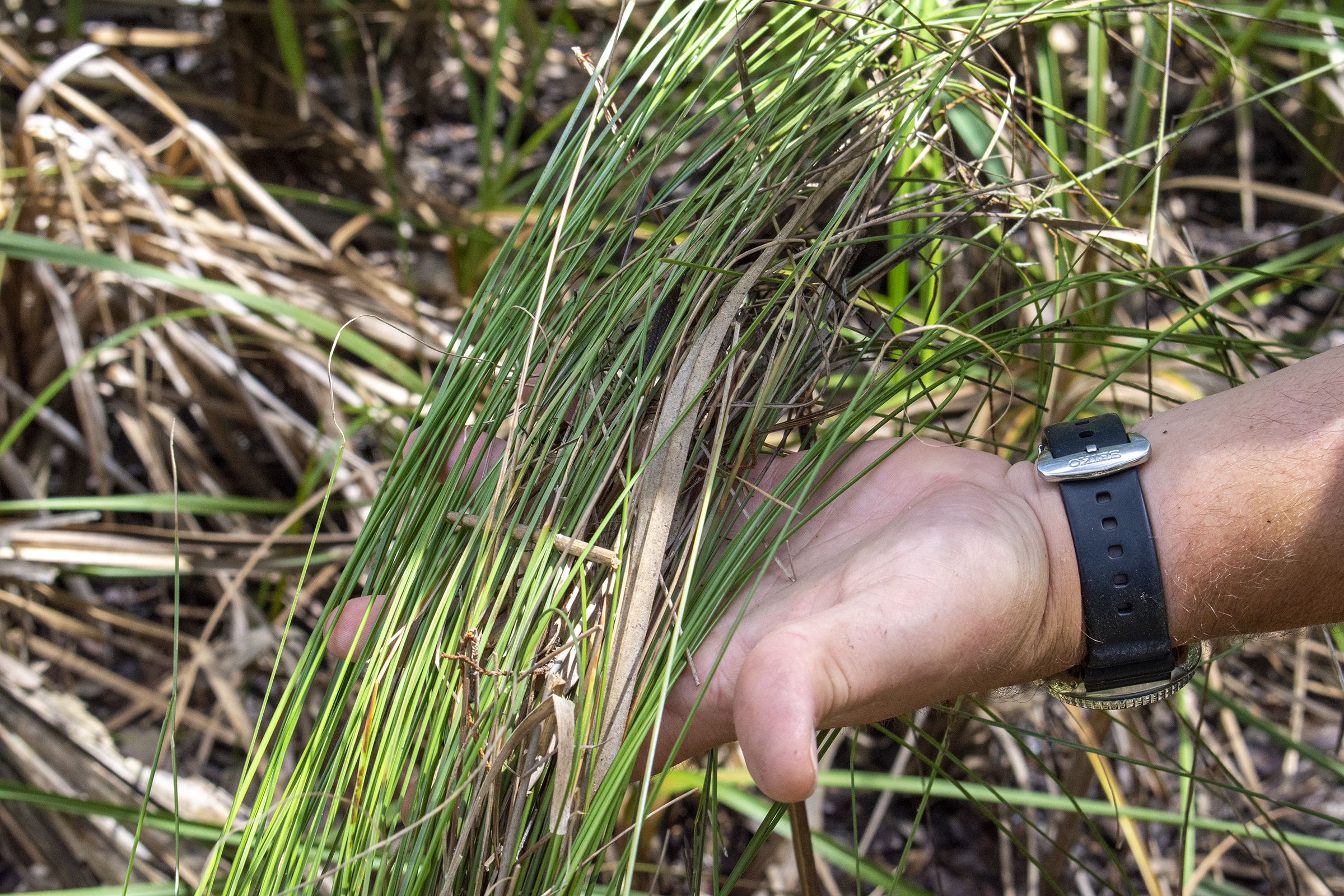 Saltmeadow cordgrass (Spartina patens), a relative of the widespread marsh plant, smooth cordgrass, grows in wispy bunches in the dunes. Its habitat is not confined to beaches, but includes brackish and salt marshes along the coast from Maine to Texas. If you look at a salt meadow cordgrass leaf, you’ll notice that it is not flat, but the edges curl up into a U-shape.
Saltmeadow cordgrass (Spartina patens), a relative of the widespread marsh plant, smooth cordgrass, grows in wispy bunches in the dunes. Its habitat is not confined to beaches, but includes brackish and salt marshes along the coast from Maine to Texas. If you look at a salt meadow cordgrass leaf, you’ll notice that it is not flat, but the edges curl up into a U-shape.
If you’re one who frequents the coastal regions, beach pennywort (Hydrocotyle bonariensis) is no doubt a familiar sight. This plant, whose scalloped, round leaves poke above the sand in profusion, is related to many other species of Hydrocotyle commonly found in coastal areas. Some species crop up in lawns and flower beds, much to the frustration of conscientious gardeners.

